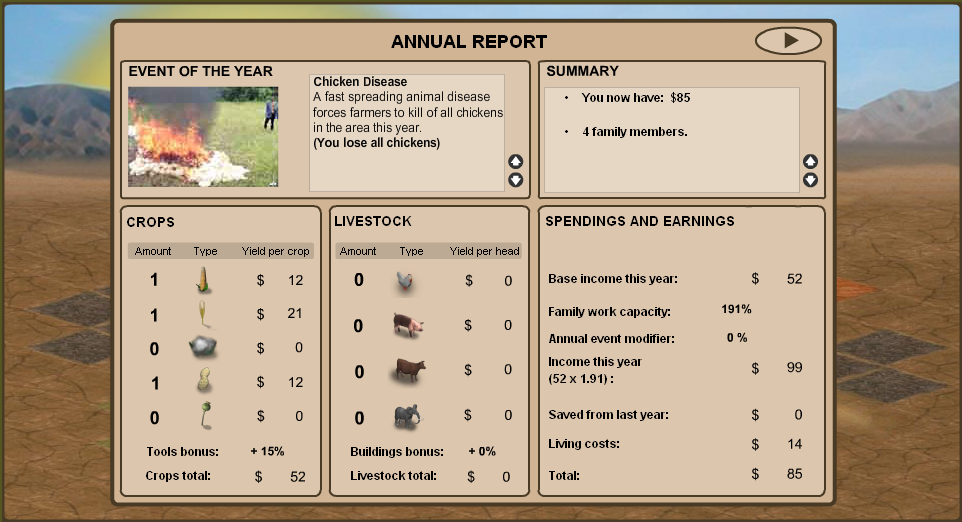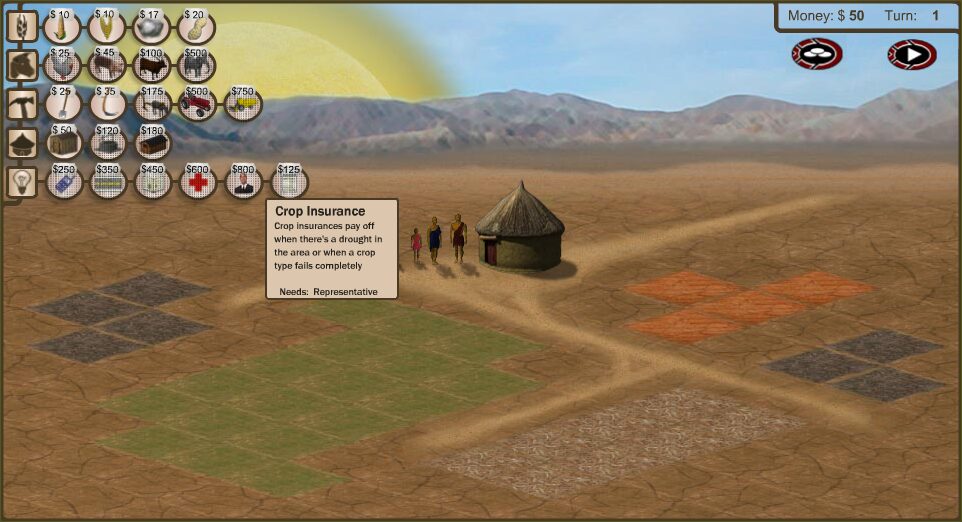Retro Replay Review
Gameplay
3rd World Farmer presents a simulation-driven gameplay loop that revolves around managing a small family of subsistence farmers in a developing country. Each turn, players allocate limited resources—choosing which crops to plant, livestock to raise, and tools or structures to invest in—while balancing the immediate need for survival against long‐term community development goals. Decision trees extend to education, medical care, and even sending family members to seek work in the city, creating a web of interlocking choices that underscore the harsh realities faced by rural households.
(HEY YOU!! We hope you enjoy! We try not to run ads. So basically, this is a very expensive hobby running this site. Please consider joining us for updates, forums, and more. Network w/ us to make some cash or friends while retro gaming, and you can win some free retro games for posting. Okay, carry on 👍)
What sets this game apart from typical strategy titles is the ever-present influence of randomness and external shocks. After each farming season, the “event of the year” triggers everything from bumper harvests to civil wars, droughts, or disease outbreaks. These events can upend even the most carefully laid plans, forcing players to adapt on the fly or witness their family’s steady decline. The unpredictability emphasizes the fragility of life in economically unstable regions and challenges players to think several moves ahead.
Despite—or perhaps because of—its unforgiving ruleset, 3rd World Farmer remains engaging through its moral dilemmas. When disaster strikes, players sometimes face grim choices: sell a child, lease land to hazardous industries, or cut back on essential expenditures. These narrative forks disrupt any building momentum typical of the genre and drive home the game’s serious message. By foregrounding harsh concessions rather than easy victories, the gameplay mechanics foster empathy and awareness rather than mere points or high scores.
Graphics
Visually, 3rd World Farmer adopts a minimalist, almost utilitarian presentation. The overhead farm map, simple icons for crops and livestock, and basic UI elements focus attention on decisions rather than eye-candy. While this lack of graphical flair may deter those expecting lush environments or high‐resolution textures, the stripped-down style serves the simulation’s educational purpose by eliminating distractions.
The game’s visual cues—colored bars for family health, income charts, and alert symbols for events—are clear and functional. Pop-up illustrations accompanying random events convey emotional gravity without resorting to graphic imagery. These simple sketches, combined with concise text summaries, effectively communicate crises like drought, disease, or political unrest, ensuring players understand the stakes without overwhelming them with detail.
In an era of photorealistic graphics, 3rd World Farmer’s aesthetic might feel dated, but it remains perfectly suited to its message. By focusing on data-driven visuals and straightforward icons, the game maintains a sharp pedagogical edge. Those seeking rich artistry may find it lacking, yet anyone interested in thoughtful design that reinforces thematic depth will appreciate how form follows function here.
Story
Rather than following a predefined narrative arc, 3rd World Farmer weaves its story emergently through player actions and random events. Each playthrough generates a unique chronicle of aspirations, setbacks, and community growth. One season might end in jubilant yields, while the next could see a family wiped out by guerrilla raids or banking collapses. This dynamic storytelling model ensures that no two campaigns feel identical.
Embedded within these mechanics are poignant vignettes: a spouse succumbing to illness for lack of healthcare, children torn between schooling and labor, or offers from shadowy actors that test moral convictions. Though the game never scripts specific character backstories, the cumulative effect of these choices and calamities fosters a powerful emotional resonance. Players often find themselves deeply invested in each family member’s survival and prospects.
The real narrative thrust lies in the contrast between players’ build-and-prosper instincts and the game’s harsh reality checks. Deploying rhetorical tension, 3rd World Farmer subverts genre conventions to highlight systemic inequities in developing regions. By challenging players to reflect on privilege and resilience, the game transcends mere entertainment, delivering a sobering commentary on global poverty.
Overall Experience
3rd World Farmer stands out as a compelling blend of strategy and serious gaming, marrying accessible browser‐based design with meaningful social commentary. Its steep difficulty curve and unpredictable events may frustrate some, but for players committed to understanding the precarious nature of rural livelihoods, the payoff is substantial. The learning curve is gentle enough for newcomers, yet the depth of simulation and emergent storytelling offer replay value for seasoned strategists.
While the game’s austere presentation and lack of traditional win conditions may not satisfy those seeking a more polished or goal‐oriented experience, it excels in fostering empathy and awareness. By guiding players through the hardships of crop failures, economic shocks, and moral compromises, 3rd World Farmer leverages gameplay as a conduit for real‐world issues. The built-in encouragement to explore relief agency websites at game’s end underscores its call to action.
In sum, 3rd World Farmer delivers a unique, thought-provoking experience that challenges conventional notions of “fun” in gaming. Although it forgoes flashy visuals and straightforward victories, its strengths lie in educational impact, ethical complexity, and emotional engagement. For those open to a sobering simulation that doubles as a lesson in global development, this game offers a rare and unforgettable journey.
 Retro Replay Retro Replay gaming reviews, news, emulation, geek stuff and more!
Retro Replay Retro Replay gaming reviews, news, emulation, geek stuff and more!









Reviews
There are no reviews yet.